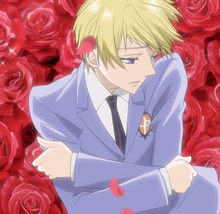Bishōnen (美少年, also transliterated About this sound bishounen), is a Japanese term literally meaning "beautiful youth (boy)". The equivalent English concept is a "pretty boy".
The term describes an aesthetic that can be found in disparate areas in Asia: a young man whose beauty (and sexual appeal) transcends the boundary of gender or sexual orientation. It has always shown the strongest manifestation in Japanese pop culture, gaining in popularity due to the androgynous glam rock bands of the 1970s, but it has roots in ancient Japanese literature, the homosocial and homoerotic ideals of the medieval Chinese imperial court and intellectuals, and Indian aesthetic concepts carried over from Hinduism, imported with Buddhism to China.
Today, bishōnen are very popular among girls and women in Japan. Reasons for this social phenomenon may include the unique male and female social relationships found within the genre. Some have theorized that bishōnen provide a non-traditional outlet for gender relations. Moreover, it breaks down stereotypes surrounding feminine male characters. These are often depicted with very strong martial arts abilities, sports talent, high intelligence, or comedic flair, traits that are usually assigned to the hero/protagonist.
Origin[]
The prefix bi (美) more often than not refers to feminine beauty, and bijin, literally "beautiful person", is usually, though not always, used to refer to beautiful women. Biseinen is to be distinguished from bishōnen as seinen is used to describe men who are of age, including those who have entered or completed tertiary education. The term shōnen is used to describe boys of middle and high school age. Last, bishota can be used to refer to a beautiful, pre-pubescent male child or a child-like male. Outside Japan, bishōnen is the most well-known of the three terms, and has become a generic term for all beautiful boys and young men.
The aesthetic of the bishōnen began as an ideal of a young homosexual lover, originally embodied in the wakashū (若衆, literally "young person", although only used for boys), or adolescent boy, and was influenced by the effeminate male actors who played female characters in kabuki theater. The term arose in the Meiji era, in part to replace the by then obsolete erotic meaning of the older term wakashū, whose general meaning of "adolescent boy" had by this point been supplanted by the new term shōnen. The bishōnen was conceived of as "esthetically different from both women and men [...] both the antithesis and the antecedent of adult masculinity".
The bishōnen is typically slender, with clear skin, stylish hair, and distinctly feminine facial features (such as high cheekbones), but simultaneously retains a male body. This androgynous appearance is akin to the depiction of angels in Western renaissance art, with similar social roots for this aesthetic.
The aesthetic of the bishōnen was recorded in Lady Murasaki Shikibu's Tale of Genji, written in about the year 1000 A.D. Genji concerns the exploits and romances of a young prince, the son of an emperor and beloved concubine, who is not in line to inherit the throne, and follows his intrigues through the court as he comes of age. The novel typifies the Heian age of Japanese history, a period of highly-stylized romance. Prince Genji's beauty is described as transcendental, so much so that "one could have wished him a woman", with a bewitching attraction that is acknowledged by men and women alike.
Minamoto no Yoshitsune and Amakusa Shirō have been identified as historical bishōnen. Ian Buruma notes that Yoshitsune was considered by contemporaries to be not physically prepossessing, but that his legend later grew and due to this, he became depicted with good looks. Abe no Seimei was depicted according to the standards of a Heian-era middle-aged man, but since 1989 he has been depicted as a modern-style bishonen
Kyokutei Bakin wrote many works with nanshoku undertones featuring bishonen characters, and in 1848 he used the term bishonen in the title of a work about the younger wakashu partner in the nanshoku relationship.
The bishōnen aesthetic is perpetuated today in anime and manga, especially shōjo and yaoi.
Usage[]
Some non-Japanese, especially American, anime and manga fans use the term to refer to any handsome male character regardless of age, or any homosexual character. In the original Japanese, however, bishōnen applies only to boys under 18. For those older, the word bidanshi, literally

Tamaki Suoh from the anime Ouran High School Host Club.
"handsome man" is used. In the place of bishōnen, some fans prefer to use the slightly more sexually neutral bishie (also spelled as bishi) or bijin, but these terms remain less common. The term binanshi was popular in the 1980s. Bishōnen is occasionally used to describe some androgynous female characters, such as Takarazuka actors, Lady Oscar in The Rose of Versailles, or any women with traits stereotypical to bishōnen.
Bishōnen is also used to describe an anime or manga character who is drawn as if a female, but has male components. This would make it easier for the artist to create a feminine male, rather than drawing a male character regularly.
Bishōnen and Bishōjo[]
Bishōjo ("beautiful girl") is often mistakenly considered a parallel of bishōnen, because of the similar construction of the terms. There are major differences between the two aesthetics. The bishōjo aesthetic is aimed at a male audience, and is typically centered around young girls, drawn in a cute, pretty style; bishōnen is centered around teenage boys, drawn elegantly. Another common mistake is assuming that the female characters in bishōnen manga and anime are bishōjo. In truth, female characters in bishōnen manga are very different from those in bishōjo; bishōjo females are usually more petite and drawn in a style that is cute rather than beautiful, whereas bishōnen females exhibit the long limbs and elegance of the bishōnen.
